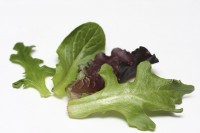Salad Days
An assortment of greens makes eating well easy
Greek, Cobb, Caesar, chef. Chopped or layered. Before the entrée, after the entrée or the entrée itself. Sweet, tart, spicy, savory. Apparently the salad is one food that has successfully been able to cross all international boundaries and break classic culinary rules while still emerging victoriously. In honor of National Salad Month, we take a peak under the leaf to see how this tossed treat got its head start.
According to the Oxford Companion to Food, the word salad is derived from “sal,” the Latin word for “salt,” which led to “salata,” or “salted things.” The old French version showed up as “salade,” while in England it was known as “salad” or “sallet.” While salads have existed in some fashion since the ancient Greek and Roman times, some believe that it was the Chinese who developed the concept of greens dressed with a salty-vinegary liquid when they drizzled soy sauce over Chinese cabbage and bok choy. Also during this time (as far back as 4,500 years ago), it is believed that the Egyptians were consuming salads (they considered lettuce an aphrodisiac). In the 14th century, European royalty became quite fond of these delicate, leafy dishes and they began to combine a plethora of exotic ingredients, including violets, rose petals and marigolds into one gigantic bowl.
Today, salads are created from practically any combination of vegetables and fruits, from avocados to zucchini, but the vast majority of these bountiful blends still begin with a foundation of one basic ingredient: lettuce. One of the oldest known vegetables, lettuce evolved from prickly lettuce, a wild plant found in Eastern Mediterranean and Western Asia that was originally used for medicinal purposes. Believing that a romaine-type lettuce cured him of an illness, the emperor Caesar Augustus had a statute made memorializing the leafy plant. In China, where lettuce has been growing since the fifth century, lettuce represents good luck. By the Middle Ages, many types of lettuce had become available throughout Europe; later Christopher Columbus introduced the delicate vegetable to North America. During the 17th century, Spanish missionaries planted it in California, known as the lettuce capital of the United States, but it did not enjoy countrywide popularity until the mid-1800s, with the advent of railway transportation and refrigeration.
It was not that long ago that you had to visit a specialty store or farmers’ market to find something beyond iceberg and Romaine. More and more exotic lettuce options are now available in typical supermarkets as consumers continue to become more health conscious and savvy. Low in calories and packed with nutritional value, most dark leafy greens are a good source of vitamin C, beta-carotene, iron, calcium, folate and dietary fiber. There are hundreds of varieties of lettuce, all of which fall under four basic categories.
Crispheads: Commonly referred to as iceberg lettuce, particularly in the United States, this pale green variety comes in the form of large rounded heads of tightly over-wrapping leaves. A tight, dense head that resembles cabbage, iceberg is the least nutritious of the salad greens. It is known for its crisp texture and mild flavor.
Romaine or Cos: The key ingredient in Caesar salads, this lettuce has gained tremendous popularity in the past decade. Packed with vitamins and nutrients, it is a tall lettuce with dark green, rigid leaves that are tightly packed together. It has a crisp texture and is considered to be one of the most flavorsome varieties.
Butterhead: Generally smaller than other types, the leaves of this variety are not as tightly packed and have a more tender, fleshy quality than crisphead. This lettuce has a smooth, light, buttery flavor and delicate leaves; most varieties are light-to-medium green in color. Examples include Boston lettuce, which resembles a blooming rose and Bibb that has a small cup-shaped appearance.
Leaf: Also known as looseleaf, this variety does not grow to form lettuce heads, but instead the leaves are joined at the stem. Looseleaf lettuce resprouts from a cut stem without losing quality in flavor or texture. The loose rosettes of leaves come in a range of flavors and colors, from various shades of green and burgundy to speckled types. Examples of this variety include oak leaf, red leaf and green leaf.

Common lettuce varieties
Arugula: Also called rocket or roquette, this fast-growing variety is characterized by small, flat leaves with long stems and a peppery taste.
Belgian Endive or French Endive: A family member of chicory and escarole, with tightly packed leaves and bulletlike shape, it is creamy yellow or white in color with a slightly bitter taste and crisp texture.
Chicory or Curly Endive: Slightly bitter, with darker outer leaves and paler or even yellow leaves toward the center. The leaves are ragged-edged on long, thin stems.
Escarole: Another member of the chicory family, this lettuce has broad wavy leaves and a milder taste than chicory.
Radicchio: This variety resembles red cabbage but is actually a member of the chicory family. This leaf is typically used for an accent in salads because of its steep cost, as most radicchio lettuce arrives from Italy.
Information courtesy of FruitsandVeggiesMatter.gov.Salad Days
